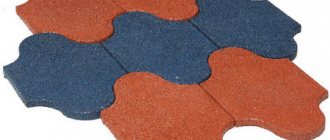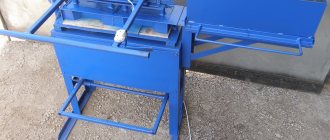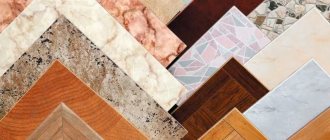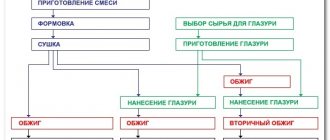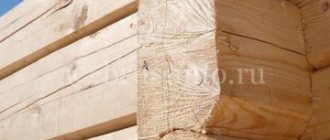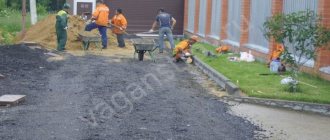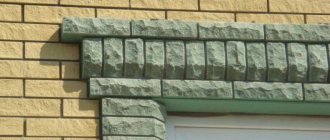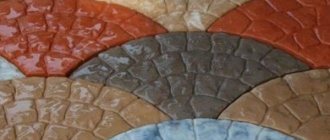Crumb rubber tiles are a facing material that can be made from rubber waste, such as old tires. But the material is durable and flexible; it is suitable for cladding surfaces in administrative buildings, non-residential premises, as well as for external work.
Our article will be devoted to the production of tiles from rubber crumbs with your own hands. The option of producing tiles as a small business is being considered.
What are rubber tiles made of?
Rubber tiles are made from old rubber, such as old car tires and other things. But before starting work, the rubber must be specially crushed into small fractions.
The composition of the future paving stones includes:
- fine rubber fraction;
- polymer glue, which acts as an astringent;
- dyes that are designed to give the finished product the light that you need;
- Modifying additives: will help make paving stones strong and durable.
How to make rubber tiles yourself?
Crumb rubber is not concrete that you can make yourself. Therefore, in order to make rubber tiles, you need to purchase special equipment, including a grinder or crusher, a large mixing mold, and a vacuum press for hot pressing. This equipment is quite expensive. If, in addition to using tiles on your own site, you plan to sell these products, then the purchase of equipment will be justified. If you need tiles only for personal use, it is better to purchase finished products. Moreover, you can choose from the variety of offered assortment what you need.
Using rubber tiles to arrange your personal plot will bring a lot of pleasure during operation.
You just need to lay it out correctly, and then it will be strong, durable and aesthetically pleasing for a long time. After all, she is not afraid of any external influences or natural disasters.
Pros and cons of rubber tiles
Rubber paving stones have undeniable advantages:
- plasticity;
- strength;
- resistance to moisture and temperature changes from -45 to +60C;
- resistance to alkalis and acids;
- ease of installation;
- a rough surface will be injury-free.
Advantages of rubber tiles - video
Minuses
- rubber may not fit into the landscape design, because it is a more functional and economical option rather than one with high aesthetics;
- Installation of rubber tiles requires skill and preparation of the base.
DIY rubber tiles. Do-it-yourself rubber tile production
Rubber tiles have recently become quite common in landscaping; you can make them yourself, which will save you money. As a result, it will be possible to obtain products that have a bright appearance and are easy to install.
Features of rubber tiles
Despite the fact that rubber tiles appeared on the Russian building materials market relatively recently, they have managed to gain worthy positions, because the products have excellent qualities, including anti-slip features that allow the tiles to be used at any time of the year. If a crust of ice forms on the surface of the coating, you can get rid of it by using a crowbar.
Rubber paving slabs made from crumbs have a long lifespan, the material is quite durable and does not wear out under significant mechanical stress.
You will not encounter the problem of puddles forming on the surface of paths made of this tile, since it has a drainage effect due to its porous structure. The products allow moisture to pass through quite well.
After the products are ready, they can be laid on any type of base, this could be, for example, gravel, soil, concrete, sand, and asphalt.
Raw materials for making tiles
Do-it-yourself rubber tiles are made using crumb rubber, which acts as a recycled product from car tires. The starting material is rubber, which can be natural or artificial.
This determines the strength qualities of the final coating, as well as its extremely high resistance to mechanical wear.
Thus, the production of the described products allows us to perform two functions, one of them is the production of material with excellent performance qualities, while the second is expressed in the safe disposal of unnecessary goods.
Technical equipment
Do-it-yourself rubber tiles can only be made if you have the appropriate equipment, which has a very impressive cost.
If you intend to engage in manufacturing for running a business, then purchasing it is advisable, whereas if you are faced with the task of laying a path on a personal plot, then it is preferable to purchase the products ready-made; it will be cheaper even than the option in which the installations are rented.
To carry out work on the production of rubber tiles you should buy:
- heating cabinet;
- mixer;
- hole jig;
- Hydraulic Press;
- set of forms;
- platform, tables and stands for the mixer.
If you plan to purchase such equipment, then you will have to pay approximately 1,590,000-2,370,000 rubles. In the minimum price option you will receive the most modest set of equipment, while the highest price includes a mini-factory.
Technological production process
Do-it-yourself production of rubber tiles is carried out by the method of initially removing steel elements from tires.
Afterwards, the prepared rubber products are crushed to particle sizes ranging from 1 to 4 mm.
Then the crumbs are combined with a binder polyurethane mixture, pigment and brought to a homogeneous state. The mixture must be poured into molds, subjecting future products to vulcanizing pressure.
Making rubber tiles with your own hands can be done by hot or cold pressing, but both of these processes are carried out when exposed to elevated temperatures. In the first case, the temperature is maintained at 140 °C for a quarter of an hour, while in cold processing the products undergo a four-hour treatment at 80 °C.
If we consider the final quality characteristics of the finished product, then both of these methods are equivalent, and in terms of energy consumption, the methods are also equivalent.
But if you set up a production line yourself, the “hot” method will be much cheaper, but if you want to increase productivity, then you should choose the “cold” finishing technology.
Production Features
If your business is based on rubber tiles, you can produce them yourself by investing approximately 2 million rubles. This includes startup costs and equipment.
Any beginning businessman is interested in the question of when the business will begin to pay off. In the described case, this will happen in about 6 months.
Rubber tiles can be supplied to stores, from where they will be purchased for arranging children's and sports grounds, private garages, garden paths, gazebos, and terraces.
The myth about the production of rubber tiles
Despite the fact that rubber tiles are available in stores at affordable prices, home craftsmen continue to produce them with their own hands. But there are still myths about the quality or production process.
One of them is expressed in the fact that products produced by the hot pressing method are not of such high quality compared to analogues that are obtained using cold process technology. This statement absolutely cannot be considered correct.
This is now being refuted by production companies that use both methods.
Carrying out installation
Laying rubber tiles with your own hands begins with arranging beacons. Afterwards the area is prepared. Initially, crushed stone is laid out on the ground; it will act as a drainage layer. Be sure to lay it on a base with some slope, this will allow wastewater to flow to the sewer.
A curb should be placed along the edges of the path, otherwise the sidewalk will creep at the first spring melting of the snow. Before you begin installing the tiles, you should lay a layer of sand. For this purpose, it is recommended to use exclusively clean sand, which does not have additional impurities.
The thickness of this layer should be approximately 5 cm.
Laying of products should be carried out along a pre-stretched cord, which is located along the perimeter of the marked area; it can be stretched along pre-installed pegs. After every 3 laid rows, it is necessary to carefully analyze the evenness of each tile individually.
You can allow some error, which is limited to 0.5-1 cm. Once one element is in its place, you can correct its position by gently tapping it with a rubber hammer.
If the area allocated for the path remains free at the edges, it can be filled with slab elements, which are recommended to be cut using discs with diamond chips.
Final installation work
Having completed laying the tiles, its surface must be compacted using a vibrating plate and covered with clean sand, after which it must be swept out, which will allow the seams to be clogged.
Tiles made from rubber crumbs can be used to improve your garden plot.
Do-it-yourself rubber paving slabs can be made in a short time, and then they will fit into any exterior and last for quite a long period of time.
Where is it used?
Application of rubber tiles:
- Playgrounds;
- Treadmills and more;
- Parking;
- Flooring of administrative buildings;
- As part of landscape design.
Raw material: rubber
Where can you find enough raw materials to produce paving stones?
Rubber tiles made from tires are a common practice. The cost of old tires depends on the quality of the rubber, tire dimensions, and manufacturer. The average price for black chips is 17-20 thousand rubles, and for colored chips - 10 thousand more.
You can buy old tires from auto repair shops, individuals, and small businesses. But it’s easier to buy crumb rubber right away. It is sold by factories that process tires into crumbs or by factories that restore tires by treating the tread. In this case, crumb rubber is a production waste.
Workshop for the production of rubber tiles
The production of rubber tiles is a developing industry, which, according to economists, is promising and in demand. The products are made from crumb rubber - waste from car tires.
The mini-business is low-cost due to the use of recycled materials, while the quality of the rubber tiles remains at a high level.
The profitability of a business will depend on product production technology, a well-designed business plan, workplace and sales.
Company organizational plan
An important section in a business plan is drawing up an organizational plan for the company. It should reveal the formation of the production process in stages. It includes planning the type of ownership, organizing production premises and equipment, hiring personnel and other organizational issues.
Registration
To carry out activities in the production of rubber tiles, the enterprise must be registered. Submit documents to the Federal Tax Service at the location of the organization. The submitted forms must reflect:
- organizational form: individual entrepreneur or LLC;
- activity code, which is selected from the directory;
- taxation system: simplified tax system, UTII, general or patent.
Registration as an LLC is more complicated due to the preparation of a larger number of documents, while the founders are liable for debts only with the property of the organization. An individual enterprise is easier to register and it is not necessary to keep accounting records, but the organizer is liable for debts with all his property.
When producing rubber tiles, a simplified taxation system is best suited, which exempts you from paying some taxes. Filing reports is easier than with an LLC.
The period for reviewing documents is 5 days.
Room
To organize a workshop for the production of rubber tiles, you need to rent a room with an area of 80–100 square meters. m.
Features of the production workshop:
- the air temperature must be at least 5°C;
- ceiling height - 3 m;
- high-quality ventilation system;
- powerful power supply - 380 V;
- good access for trucks.
The room for organizing the work process must be divided into zones: office, warehouse and workshop. Warehouse space will be needed to store raw materials and finished products. In the administrative zone, work is organized on cost accounting, purchase of materials, sales of finished products and advertising. The workshop is the main production room in which the production of rubber tiles takes place.
Staff
The number of employees depends on the volume of production and sales. At the initial stage, work is organized 5 days a week with an eight-hour working day. To operate one automated belt, 1–3 people are enough.
After organizing an established sales scheme, you can introduce 2 or 3 work shifts with an increase in the number of operators.
The staff must also include:
- accountant;
- Sales Manager;
- technologist;
- loader;
- driver.
At the initial stage, some positions can be combined by the owner of the production. An accountant and a technologist can work part-time at a quarter rate.
Where to get raw materials
The main raw material for the production of tiles is crumbled rubber, which is obtained by crushing car tires. The cost of waste depends on the size of the fraction - from 14 to 25 rubles.
You can buy raw materials:
- in waste recycling companies - used car tires;
- in factories that retread tires by surface treatment;
- at enterprises producing rubber technical products.
Rubber tiles also contain other components: polyurethane adhesive and pigment dyes. Materials can be purchased at construction stores at wholesale prices.
To independently produce waste from car tires, you need special equipment, which requires additional financial investments and technological knowledge. Finding and collecting car tires takes a lot of time and costs, so the production of recycled materials is a separate business idea in the manufacturing sector.
Sales and advertising
At the stage of drawing up a business plan, it is necessary to analyze the market for products in your region.
Rubber tiles are used to form flooring:
- on sports and children's playgrounds;
- in garages, workshops, warehouses and other cold rooms;
- in bathhouses, on terraces, gazebos;
- on livestock farms;
- other places.
To sell products, it is necessary to organize meetings with representatives of companies that use rubber tiles with offers of their products. It is also necessary to search for potential buyers.
To develop a business, it is important to advertise your products. To do this, you can disseminate information about the company and products:
- on TV;
- radio;
- in printed publications;
- place advertising stands;
- hand out business cards in shopping centers.
Owners often use advertising about the company placed on the awning of trucks.
Profit, payback and profitability of the project
The return on business depends on the initial investment and monthly revenue. An example of calculating the profitability of an enterprise;
- initial costs - 1,500 million rubles;
- daily production of products - 20 sq. m;
- cost of 1 sq. m. tiles - 1600 rubles;
- revenue for the year: 20x1600x21x12=8,064 million rubles (21 working days per month);
- monthly costs - 500 thousand rubles;
- monthly income: 20x1600x21 = 672 thousand rubles;
- monthly profit: 672 – 500 = 172 thousand rubles;
- payback of the enterprise in 9 months: 1500/172 = 8.7 months;
- business profitability per month: 172 / 672 *100% = 25%.
With an increase in production and sales of products, the payback of the mini-business will come faster.
The production of tiles, with a properly drawn up business plan and the establishment of the implementation process, quickly brought profit. The use of secondary raw materials to form products allows you to organize an enterprise with minimal initial capital. We recommend looking at existing manufacturers of rubber tiles and conducting competitive intelligence.
Crushing methods
There are two main methods used in production:
- mechanical crushing;
- shock wave crushing.
Mechanical crushing involves grinding the material using special cutters. The low cost of equipment and simple technological process make this method popular and often used.
- The metal seating ring is removed;
- The rubber tire is cut into strips 5-7 cm wide;
- The remaining seat rings are removed;
- The rubber is crushed to obtain crumbs with a fraction of 5 mm;
- Finally, the resulting crumbs are sorted into fractions.
Shock wave crushing and grinding requires the use of special equipment. In a specially equipped chamber, the rubber is subjected to shock wave treatment. The entire process is automated and requires the participation of one operator.
How the described material is made
Typically, the production of rubber tiles begins with the processing of recyclable materials. Old tires can be shredded in two ways:
- Using mechanical crushing. To implement this, cutting machines are used. They are inexpensive, anyone can work with them, so the cost of producing raw materials is quite low.
- Using shock wave crushing. To carry it out, old car tires are placed in special chambers, then they are subjected to a certain effect, as a result of which crumbs are obtained. This process is fully automated and can be controlled by one person. Due to the high cost of installation, the cost of raw materials increases.
Note! Before sending the tires to the crusher, all metal parts are removed from the car tires, then they are cut into strips 5 cm wide. And only then the blanks are sent to the crusher, where they are cut into the sizes of the specified fractions.
What fractions of crumb rubber are required?
Crumb fractions vary from 0.1 to 10 mm. Small fractions (0.1-4 mm) are used to make single-layer tiles, both black and other colors.
Fractions of 2-10mm are used for the lower layers of rubber paving stones.
If the thickness of the tile is more than 1.5 cm, you can make the tile two-layer. So the bottom layer will be made of coarse fraction, and the top will be made of fine and more expensive crumbs.
Two-layer paving stones created according to this principle have its advantages:
- cost savings: fine fractions are more expensive;
- Saving dye: you can paint only the top part of the tile, and the bottom remains black;
- Less binder will be required for a large fraction.
How to make a covering from crumb rubber with your own hands - technology and tips
Each of us wants any “cladding” to be inexpensive, and to last as long as possible, and without frequent repairs (and ideally, without it at all).
And so that the material does not get wet, does not crack, does not fade from ultraviolet radiation and many other things one dreams of. But practice shows that there are no universal products.
Even with numerous “pluses” there is always some kind of “minus”. And according to the “law of meanness,” it is precisely this that is essential for us.
Let's consider one of the most common problems - the choice of a suitable material for finishing horizontal surfaces that experience mechanical loads.
Often you have to think about how best to make the floor in the garage, cellar or basement of your home. It is probably not an exaggeration to say that the issue of arranging areas for a car on a personal plot worries many.
What about the paths in the garden (or backyard) area? This is the scourge of many “private owners”.
Some of them solve this problem simply - they leave grass on them so that in rainy weather they do not “knead” the dirt. But the vegetation not only rises up, it also “creeps” onto the beds.
Anyone who has a dacha knows how much time it takes to put the paths in order. This problem can be solved differently. For example, lay out the paths with some kind of material.
But here too there are difficulties.
Firstly, you will have to level the entire route, backfill the “substrate” and much more.
Secondly, it is not always convenient to carry out work in conditions where the path has a complex configuration (due to the specific layout of the territory). For example, for slabs everything needs to be done “parallel” and “perpendicular”. And you can’t roll up the asphalt in a zigzag.
Thirdly, labor costs and “issue price”.
Here are just a few examples of the cost of materials that can be used as flooring in utility rooms or paths on the site:
- wood - from 1,000 rubles/m² (but it still needs to be dried and impregnated!);
- concrete pouring - from 800 rubles/m² (including all necessary materials);
- sandstone – from 260 rub/m²;
- tiles – from 400 rub/m².
Now let's pay attention to the following points:
- many materials will have to be cut, sawed, and further processed;
- preparatory activities, which have already been mentioned;
- durability. Wood rots, concrete cracks, sandstone crumbles - there are many “options”.
We use crumb rubber for covering
If we talk about crumb rubber, it will cost from 380 rubles/m² (with polyurethane as a binder). As those who have already worked with this material say, any owner can do this, even without experience in such work. By the way, the recommended “fill” layer is no more than 8 cm. This thickness is quite enough.
Tracks (rolled products) are also available for sale. For example, a finished strip of crumb rubber will cost approximately 860 rubles (3 m x 0.3 m). A wider one - 60 cm, the same length - costs 1,680 rubles.
Unfortunately, little is known about such material in our country, so we will try to explain.
Product advantages
- Possibility of installation on any base. It just needs to be compacted first. The insignificant weight of the rubber crumb does not create any load on the “base”.
- A simple method of carrying out work. The main thing is to strictly follow the relevant recommendations of the Manufacturer. But this primarily concerns the issue of preparing the mass intended for “pouring”, and the process itself is quite simple. Hired professionals, who also need to be paid, are definitely not needed.
- High maintainability. If defects appear, they are eliminated using the “spot” method.
- Injury safety. Rubber crumbs after “installation” form a smooth, elastic (soft) surface.
- The addition of various coloring substances allows the treated area to fit into any landscape.
- The material is not subject to abrasion.
- Like any rubber, the products are distinguished by such properties as resistance to thermal influences and moisture.
- The material does not emit substances hazardous to health.
- Long (repair-free) service life of the coating (at least 8 - 10 years, if the installation technology was followed).
If we take into account the following “advantages” of crumb rubber: puddles will not form on the surface (the structure of the material is porous); grass grows through it; in cold weather the material will not be “torn” by ice, then the advantages of using this coating are undeniable.
But this is not the only area of application for crumb rubber. It can be used almost everywhere - on the roof of a garage, when arranging blind areas of buildings, children's or viewing platforms, and the like.
The only “difficulty” is to put up a fence so that the mass does not spill over the entire area, but remains (and freezes) within certain boundaries.
Polymer glue consumption
Polyurethane glue costs 140 rubles per kg. Consumption directly depends on the following factors:
- The amount of glue depends on the fraction. The finer the fraction, the more glue will be required.
- No dyes are needed to make colorless tiles. Dyes dry out the glue, so the consumption will be higher.
- To produce dense products, more binder is required.
Glue consumption varies from 4 to 12% depending on the conditions listed above.
Let's illustrate with an example:
- Colorless paving stones, 4-10 mm chips need 4% glue;
- Black tiles, chips 1.2-1.8 mm will require 6%;
- Colored tiles with identical chips - 7-9% glue.
Technological process
- Crushing rubber, obtaining crumbs.
- Rubber fraction, polymer glue, dyes and modifying additives are added to the mixer.
- The mixture is mixed and loaded into special molds.
- Pressing raw material into tiles of the desired thickness and shape.
- Baking is the finishing process. There are two ways: “when cold,” the molds are sent to thermal cabinets. There, the raw materials are processed at low temperatures. “Hot” vulcanization requires high temperatures.
During hot processing, pressure is applied to the tile at a temperature of 140C. The procedure takes 15 minutes. Cold processing lasts 4 hours or more, and the temperature is only 80 C.
Manufacturing technology
To produce tiles, 2 pressing methods are used:
- hot;
- cold.
The first option is cheaper and faster. But at the end you will get a toxic product of low quality. Domestic manufacturers prefer cold pressing. This method allows you to obtain durable tiles, but it is not very productive.
The energy costs for both methods are the same. Only the nature of electricity consumption differs. With the hot method, electrical energy is consumed cyclically, only during operation of the press. During cold pressing, it is necessary to constantly consume electricity to maintain the desired temperature in the drying chambers.
Let's consider the main stages of production:
- Preparatory. At this stage, the main raw materials are prepared. To do this, old car tires are freed from metal rings and textile threads, and then crushed in a crusher to the desired fraction.
- Preparation of the mixture. Rubber crumbs, glue, pigments and modifying fillers are loaded into the mixer in the required proportion.
- Molding. The finished mixture is filled into special molds and sent to the press.
- Pressing. The raw material is compressed to a specified density and thickness.
- Baking. In the hot production method, the material is baked under pressure at +130°C. The cold method involves placing molds with raw materials in ovens for processing at lower temperatures (+60°C).
It is necessary to strictly adhere to the production technology of rubber tiles. Pay special attention to the following important nuances:
- Rubber crumb size. The quality of the coating and its physical and mechanical characteristics depend on this parameter.
- Availability of lubricant in the molds before loading the mixture.
- Maintain proportions when preparing the mixture.
- To increase the water resistance of the tiles, you need to use a smaller fraction of crumbs and increase the press pressure.
- The larger the fraction of crumb rubber, the faster the color of the material is lost during operation.
- It is better to make tiles more than 2 cm thick in two layers. The top layer is made of small crumbs, the bottom layer is made of coarse crumbs. If you want to make a two-layer rubber tile, you will need an additional mixer to prepare different layers.
- One pressing machine must produce tiles of the same thickness, regardless of its configuration. The thinner the coating, the faster its formation occurs.
Many manufacturers produce two-layer rubber tiles. This approach allows them to significantly reduce the cost of the finished product, since the mixture includes a cheap large fraction of the feedstock.
Proportions
To prepare a mixture of crumb rubber, all the necessary components are taken in the following proportions:
- crumb rubber - 80%;
- polymer glue - 10%;
- pigment - 3.5%;
- modified fillers - 0.5%.
The smaller the crumb fraction, the more glue will be needed. Pigment substances dry out the binder, so there may be less of it in black tiles. Before pouring ingredients into the mixer, they must be accurately dosed using a scale. Failure to comply with the technology may negatively affect the quality characteristics of the finished product.
Hot way
For the hot method of producing tiles, you will need a vulcanization press, under which the vulcanization process occurs at a temperature of +130°C. The molds with the mixture are kept under pressure for 30 minutes. After this, you can remove the finished tiles.
Hot pressing significantly increases volumes because it speeds up the process of making tiles. However, fast is not always good.
When using the hot method, the characteristics of the product deteriorate, which negatively affects its quality. These tiles have a stronger burnt rubber smell. In addition, it quickly deteriorates under the influence of various environmental factors.
The glue should be well absorbed into the structure of the mixture components. With the hot method, it does not have time to firmly bind all the components, so the tile becomes fragile and not strong enough. Under the influence of high temperatures, the connecting links do not dry, but are baked, which negatively affects the elasticity of the tile and its strength.
Cold way
The finished rubber mixture is loaded into molds and placed under a press. After pressing, the carts with the molds are loaded into special chambers for drying. They are kept for 4-6 hours at +60°C. After this time, the carts can be removed from the chamber.
The productivity of the cold method depends on the volume of the drying chamber. The larger the chamber, the more carts it will fit. Thanks to this, you can regulate the quantity of products produced.
At first glance, it may seem that making tiles this way is less productive. During cold pressing, chemical reactions slow down, the glue has time to reliably bind all components, and as a result you get durable, high-quality material with excellent performance characteristics. Production volumes can be increased by purchasing additional equipment.
Tile production equipment
For established tile production, you will need special equipment, devices, such as molds for pouring, as well as the required number of components for making tiles from crumb rubber.
What equipment is needed?
- To avoid crushing the rubber yourself, it is better to buy crumb rubber right away.
- Crumbs, polymer glue and all additives are loaded into the raw mixer. To obtain a homogeneous mixture, construction mixers with a centrifuge are needed. The cost of a raw mixer is 100-200 thousand rubles. To avoid downtime due to untimely supply of raw materials, purchase two mixers.
- Volcanic press: it is in them that paving slabs are baked. There are two baking methods: “cold” and “hot” method. The cost of a volcanic press is 350 thousand rubles, provided that the productivity is 100 m2 per day.
Technological process for the production of crumb rubber with demonstration of equipment - video
Auxiliary devices and accessories
- Forms for pressing. The mixture will be in such molds when it enters the oven. Cost – 30 thousand rubles per piece.
- Carts for transporting raw materials: crumbs and glue around the construction site.
- Measuring scoops, mugs and other containers.
- Scales for weighing the components of rubber paving stones.
As a result, you can produce a wide range of products:
- thin and thick rubber tiles;
- waterproof and drainage, allowing water to pass through;
- black, colored and interspersed with other colors;
- with or without a picture;
- with or without locking connections;
- different hardness;
- with a rough surface.
Below are possible products, their names and parameters.
What else should you consider before starting production?
- A constant voltage of 380V is required.
- To install the necessary equipment, a room with an area of 100 m2 is required. Room height from 3 m.
- Special equipment is automated, but to keep the process going, a full-fledged working team is required.
The process of processing tires into rubber crumbs. Summary The production of rubber paving stones as a mini-business is a great idea. It is worth deciding in advance on the sales market, component suppliers and purchasing the necessary equipment.
Rubber tiles are used for garden paths, children's playgrounds, gyms, and administrative buildings. Crumb paving stones have a wide range of applications, so a quality product will always be in price.
Necessary equipment
All manufacturing stages must be carried out using special equipment for the production of tiles from crumb rubber. Therefore, the equipment comes first. What will you need to purchase?
- Volcanic press (cold or hot).
- Molds (at least three or four pieces).
- A special construction mixer that allows you to prepare the component raw materials used to produce tiles from crumb rubber.
- Thermal ovens (if the cold processing method is selected).
In addition to special equipment, you will definitely need auxiliary accessories. Such as molding tables, racks for fixing workpieces, platforms on which construction mixers are mounted.
Note! At the initial stage of organizing your own business, you can refuse to purchase auxiliary accessories. But if you are starting a program that should make a profit, it is important to purchase a whole range of special equipment.
